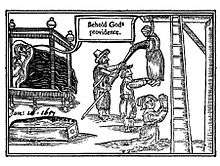Anne Greene

Anne Greene (born 1628, hanged 1650, died 1665) was an English domestic servant who was accused of committing infanticide in 1650. She is notable for surviving her attempted execution, thanks to the intervention of physicians from Oxford University.
Biography
%2C_title_page._Wellcome_L0020243.jpg)
Greene was born in 1628, in Steeple Barton, Oxfordshire. She entered the household of Sir Thomas Reade of the manor house at nearby Duns Tew as a scullery maid. She was raped by her master's grandson and gave birth to a child, which, as she alleged, and according to medical evidence, was stillborn. She was, however, sentenced to death for murder, and on 14 December 1650, was hanged at Oxford. At her own request, several of her friends pulled at her swinging body and struck severe blows so as to make sure that she was dead, and after the usual interval, she was cut down. After being pronounced dead by the prison doctor, was given over to the medical students for dissection.
A day later, when the dissection was about to be started, Oxford University physicians Ralph Bathurst, Thomas Willis, William Petty, and Henry Clerke,[1] found out that Greene had a faint pulse and was weakly breathing, and with the help of restoratives, she soon regained her health. She was revived by having hot cordial poured down her throat, having her limbs and extremities rubbed, being bled, having heating plasters applied and having a "heating odoriferous Clyster to be cast up in her body, to give heat and warmth to her bowels". After being placed in a warm bed with another woman to keep her warm, she recovered fully.[2]
She was granted a free pardon. The event was regarded as the special interference of the hand of God on behalf of the innocent, and called forth several pamphlets. The most notable of these was entitled, Newes from the Dead, or a True and Exact Narration of the Miraculous Deliverance of Anne Greene - written by a Scholler in Oxford - whereunto are prefixed certain Poems casually written upon that subject, (Oxford, 1651). The poems, of which there were 25, in various languages, included a set of Latin verses by Christopher Wren, who was at that time a gentleman-commoner (a student who paid all fees in advance) of Wadham College.
In popular culture
The character of Sarah Blundy in Iain Pears' An Instance of the Fingerpost is roughly based on Anne Greene.
Anne Greene is also the main character in Mary Hooper's young adult novel Newes from the Dead, inspired by the pamphlet of the same name.
References
- ↑ Jane Shaw, Miracles in Enlightenment England (2006), p. 58.
- ↑ Hughes 1982, p. 1783
![]()
- Hughes, Trevor J. (1982), "Miraculous Deliverance Of Anne Green: An Oxford Case Of Resuscitation In The Seventeenth Century", British Medical Journal, 285 (6357): 1792–1793, doi:10.1136/bmj.285.6357.1792, JSTOR 29509089